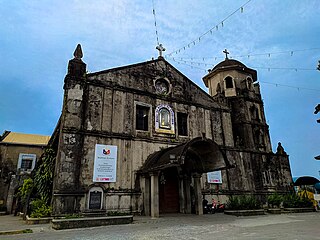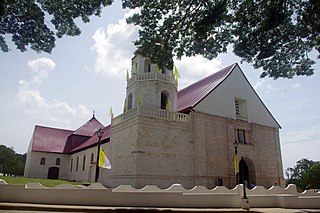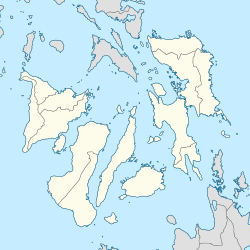
Baclayon, officially the Municipality of Baclayon, is a 4th class municipality in the province of Bohol, Philippines. According to the 2020 census, it has a population of 22,461 people.

Loboc, officially the Municipality of Loboc, is a 4th class municipality in the province of Bohol, Philippines. According to the 2020 census, it has a population of 17,418 people.
Datu Sikatuna was a Datu or chieftain of the Bool Kingdom in the island of Bohol in the Philippines. He made a blood compact (sanduguan) and alliance with the Spanish explorer Miguel López de Legazpi on March 25, 1565 at Hinawanan Bay, barangay Hinawanan, Loay. Their blood compact is the first Treaty of Friendship between Spain and the Philippines. The previous site of the pact was thought to have been at barangay Bool, Tagbilaran City but later a panel of historians concluded that the event actually happened at barangay Hinawanan, Loay, Bohol as ratified through Resolution No. 4, issued by the National Historical Institute in 2005.

The Order of Augustinian Recollects (OAR) is a mendicant Catholic religious order of friars and nuns. It is a reformist offshoot from the Augustinian hermit friars and follows the same Rule of St. Augustine. They have also been known as the "Discalced Augustinians".

The Santa Monica Parish Church, commonly known as the Minalin Church, is a Baroque Roman Catholic church, located in poblacion area of San Nicolas in Minalin, Pampanga, Philippines. The church, built during the Spanish era, was declared a National Cultural Treasure by the National Commission for Culture and the Arts and the National Museum of the Philippines on August 27, 2011, one of 37 churches in the country bestowed that honor.

Immaculate Conception Parish Church, commonly known as Balayan Church, is a Roman Catholic parish church in the town of Balayan, Batangas in the Philippines, under the jurisdiction of the Archdiocese of Lipa. The church is listed as a National Cultural Treasure as its construction was supervised by Filipino Seculars during the Spanish Colonial Period.

Saint John the Baptist Parish Church, commonly known as Liliw Church or Lilio Church, is one of the Roman Catholic churches in Liliw, Laguna, Philippines. It is under the jurisdiction of the Diocese of San Pablo. Its feast is celebrated every August 29 known as the Martyrdom of St. John the Baptist. The church is known for its red bricked façade and baroque style architecture.

The Diocesan Shrine and Parish of Our Lady of Candelaria, commonly known as Silang Church, is a Roman Catholic parish church in the municipality of Silang, in the province of Cavite, Philippines under the Diocese of Imus. Its titular is the Our Lady of Candelaria. The church is known for its Spanish colonial architectural style and the rococo-influenced retablos. It is the oldest existing stone church in the province of Cavite, having been completed in 1639.

The Saint Gregory the Great Parish Church, commonly known as Indang Church, is a Roman Catholic church in the municipality of Indang, Cavite, Philippines, under the Diocese of Imus.

Santa Cruz Parish Church, also known as Holy Cross Parish Church and Maribojoc Church, is a Roman Catholic parish church in the municipality of Maribojoc, Bohol, Philippines, under the Diocese of Tagbilaran. The parish was first established by the Jesuits in 1767 or 1768 with Father Juan Soriano, SJ as its first parish priest. The Augustinian Recollects later administered the community until 1898.

The Fort of Saint Vincent Ferrer or commonly known as Punta Cruz Watchtower (Tagalog: Bantayan ng Punta Cruz) is a Spanish colonial era watchtower located at the western tip of the municipality of Maribojoc, Bohol, Philippines. Also known as Maribojoc Watchtower because of its geographical location, it is located three kilometers (1.9 mi) away from Maribojoc Church. It is known for being the "only perfect isosceles triangle" tower-fort structure in the Philippines.

Immaculate Conception Parish Church, also known as La Purisima Concepcion de la Virgen Maria Parish Church and Baclayon Church, is a Roman Catholic church in the municipality of Baclayon, Bohol, Philippines within the jurisdiction of the Diocese of Tagbilaran. Baclayon was founded by the Jesuit priest Juan de Torres and Gabriel Sánchez in 1596, and became the oldest Christian settlement in Bohol. It was elevated as a parish in 1717 and the present coral stone church was completed in 1727. The Augustinian Recollects succeeded the Jesuits in 1768 and heavily renovated the church since then.

The Nuestra Señora de la Luz Parish Church, also known as Our Lady of Light Parish Church and commonly as Loon Church, is a Roman Catholic parish church in the municipality of Loon, Bohol, Philippines, under the Diocese of Tagbilaran. The parish was established by the Jesuits in 1753 and the original stone church was built from 1855 to 1864. It was declared as a National Historical Landmark by the National Historical Commission of the Philippines and a National Cultural Treasure by the National Museum of the Philippines.

Santa Monica Parish Church, commonly known as the Alburquerque Church, is a Roman Catholic church in the municipality of Alburquerque, Bohol, Philippines. It is under the jurisdiction of the Diocese of Tagbilaran. The church was declared as an Important Cultural Property by the National Museum of the Philippines in 2013.

The Diocesan Shrine and Parish of San Andres, commonly known as Masinloc Church, is an 18th-century Baroque Roman Catholic church located at Brgy. South Poblacion, Masinloc, Zambales, Philippines. The parish church, dedicated to Saint Andrew the Apostle, is under the jurisdiction of the Diocese of Iba. The church structure, a standout among Spanish-era churches in the Central Luzon region for having been built with coral stone instead of adobe stone, was declared a National Cultural Treasure by the National Museum of the Philippines along with 25 other Spanish-era churches in 2001.

The Archdiocesan Shrine of Patrocinio de Maria Santisima, commonly known as Boljoon Church, is a Roman Catholic church dedicated to Our Lady of the Patronage in the municipality of Boljoon, Cebu, Philippines, under the Archdiocese of Cebu.

The Immaculate Conception Parish Church, commonly known as Guiuan Church, is a Roman Catholic church in the municipality of Guiuan, Eastern Samar, Philippines, within the jurisdiction of the Diocese of Borongan.

San Isidro Labrador Parish Church, commonly known as Lazi Church, is a Roman Catholic church in the municipality of Lazi, Siquijor, Philippines within the jurisdiction of the Diocese of Dumaguete. It became an independent parish in 1857 under the advocacy of Saint Isidore the Laborer.

The Diocesan Shrine and Cathedral-Parish of Saint Joseph the Worker, commonly known as Tagbilaran Cathedral, is a Roman Catholic cathedral in Tagbilaran, capital city of Bohol province, in Central Visayas, Philippines. It is the seat of the Diocese of Tagbilaran which comprises Bohol's western half. The cathedral is located in Tagbilaran poblacion and was installed with a historical marker by the NHCP in 1953.






























